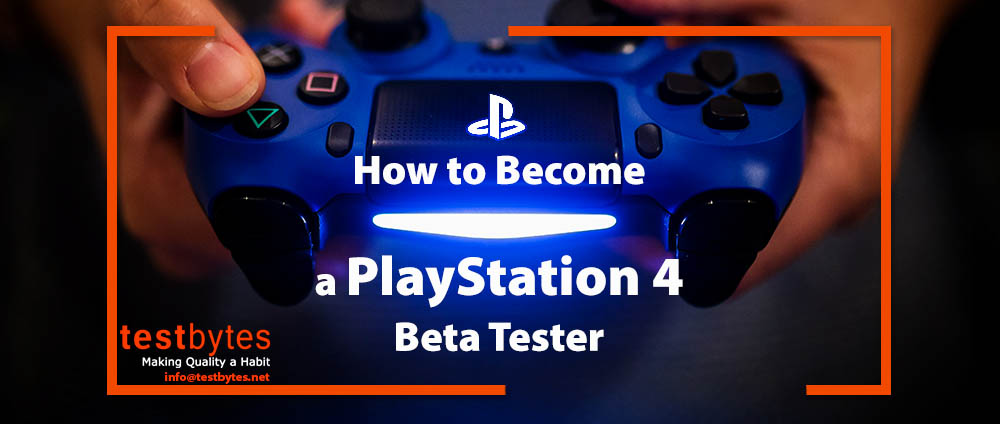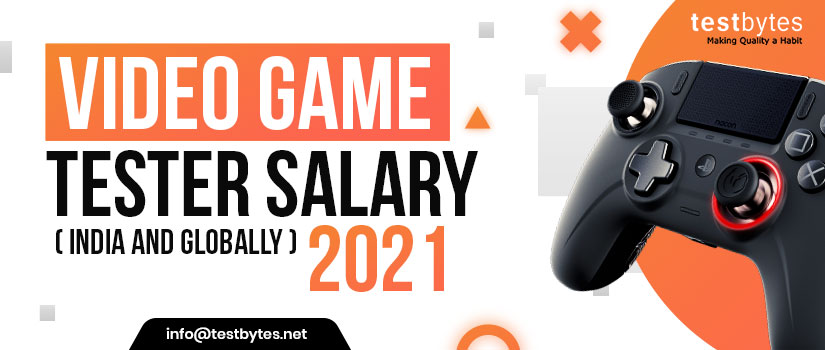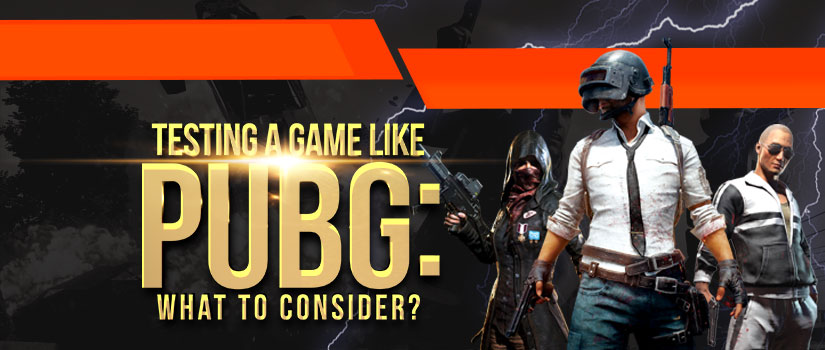Video games hold a substantial share of the software market, creating a constant demand for innovation and complexity in the gaming industry.
Game development involves a collaborative effort among various professionals, including game designers, writers, visual artists, sound designers, and, crucially, game testers.
Therefore, it is important to be aware of the comprehensive process of game development and the pivotal role played by game testing in the entire process. Understanding the intricate phases of game development and the strategic implementation of testing strategies is essential for delivering a flawless gaming experience to users.
Game Development Process: Step-by-Step
Phase #1
Conceptualization The game development journey starts with conceptualizing the game, involving brainstorming to formulate the core idea, theme, and unique selling points.
Existing intellectual properties in various media or original concepts might serve as inspiration for this fundamental idea. This stage is critical for aligning the game’s vision across the development team and stakeholders.
Phase #2
Pre-Production In pre-production, detailed game design documents (GDDs) are prepared, outlining gameplay mechanics, narratives, character designs, and environment concepts.
This phase sees the creation of technical prototypes to validate gameplay ideas and mechanics.
Storyboards and concept art are developed to visually represent game narratives, environments, and characters, facilitating a shared understanding and vision among the creative team.
Phase #3
Production The production phase marks the bulk of game asset creation and coding. It involves the detailed development of game levels, character models, textures, animations, and game-specific logic.
Programming teams work on developing the game engine (if custom), integrating third-party libraries, and coding game mechanics, physics, AI behavior, and user interface elements.
This phase requires rigorous coordination between artists, designers, and programmers to ensure consistency and adherence to the game’s vision and design documents.
Phase #4
Post-Production Post-production focuses on refining the game through extensive QA testing. The game, now in its alpha state, is scrutinized for bugs, performance issues, and gameplay imbalances.
Feedback from alpha testing leads to adjustments and bug fixes, progressing the game to a beta state for wider testing, including compatibility testing and compliance checks with platform-specific standards.
This phase is iterative, with multiple testing cycles, feedback, and refinement until the game meets quality and compliance benchmarks for launch readiness.
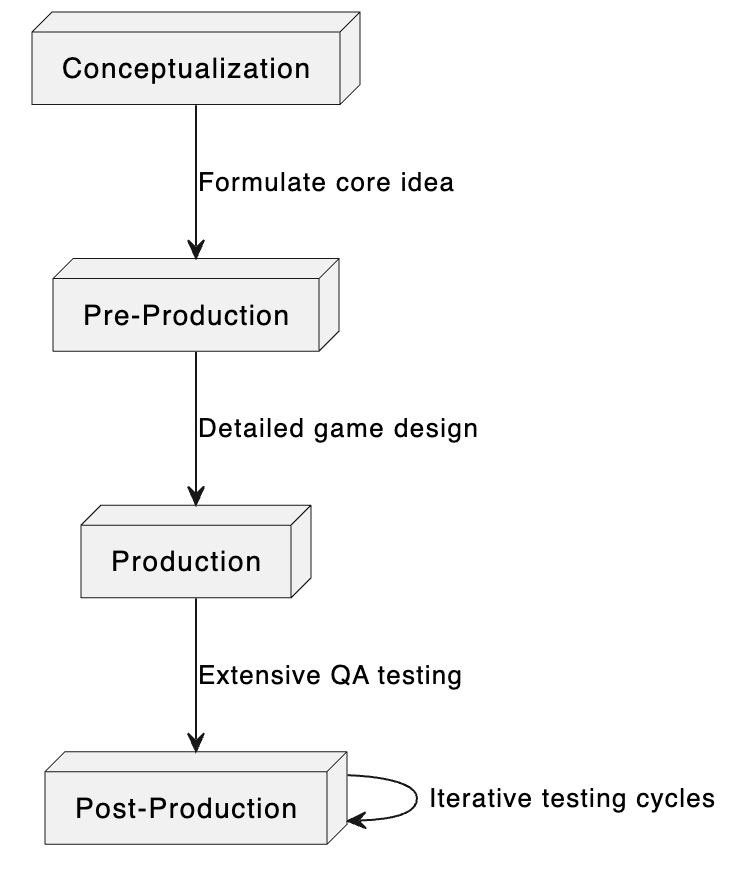
Marketing
Marketing Simultaneously with late development stages or post-production, the marketing phase ramps up to generate anticipation and demand. This includes creating promotional materials, engaging with media and influencers, and showcasing the game at industry expos.
Marketing strategies are tailored based on target demographics and platforms, focusing on highlighting the game’s features and unique aspects.
For indie developers or smaller studios, this phase might also involve direct community engagement through social media and crowdfunding platforms to build a supportive player base pre-launch.
What do you think the Game Testing Stage is intended to reveal?
The testing stage is a critical component of the game development process.
In addition, revealing potential bugs in the program—for example, in-game objects not running legitimately—. It should likewise check for irregularities in the fictional structure of the game, consistency (and culmination) of artwork, and additionally be testing the gameplay—is the game connecting with, too simple, or too hard, for instance?
Who is a Game Tester?
Game testers play a pivotal role in ensuring the quality of a game before its final release. They thoroughly test games on various platforms, including consoles and desktops, to identify bugs and defects. Without game testers, games could suffer from numerous issues, potentially damaging the reputation of the development company.
What are the requirements to Become a Game Tester
- Attentive behavior
- Understanding of video game console controllers
- Awareness of SDLC
- Good communication skills
- Great writing skills
- Primary computer programming aptitudes
Central Skills
- Principles and perception
- Analytical thinking
- Knowledge of computer hardware parts
- Investigating and exploring aptitudes
- Versatility to tedious and redundant obligations
Typically, gaming companies don’t have a specific degree requirement. The skills are quite often tested at the interview. Still, education plays a significant role in game testing. The titans of the gaming industry prefer to hire employees with degrees in:
- software development
- computer programming
- Computer science or some other technical field.
What does a Games Tester do?
Some of the key responsibilities of a game tester include the following:
- Be repetitive and unpredictable to identify and break down potential issues.
- Test different versions of games on various platforms.
- Explore specific areas of the game and test all available options.
- Play through different modes and characters to reveal glitches.
- Report errors, spelling mistakes, and language issues.
- Document bug reports in a bug-tracking system.
- Understand the difference between reporting bugs and reporting features.
- Test the game repeatedly in various conditions to ensure stability.
- Analyze new game versions to check if previous bugs have been addressed.
The process involved in Game Testing
By far, we know that testing has an imperative function in Game development. A game is tested at the distinctive level of its development procedure. Usually, in the software engineering method, the Software test design document contains all the data about testing the product. However, game testing is not quite the same as testing the software.
There are numerous steps included other than test cases for a game, generally in light of the fact that almost all game testing is black box testing. The developers generally don’t test their own games, nor do they have time to test them completely, nor is it a wise idea to test games by themselves.
Before presenting their code for integration with the rest of the game or as third-party code for use by other game developers, game developers only test small portions of it.
6 Steps of the game testing are as follows:
- Plan and Outline the Test – Although quite a bit of this plan was done before in the programming test plan document, still with each new prototype of the game, this document should be returned to upgrade any adjustments in the test cases, specifications, and new setup support. The game tester ought to guarantee that no new issues are presented.
- Set up the Test – All the teams should upgrade their code, documents, tests, and test environment and regulate it with each other. The test development group should mark the bugs settled and the test time taken to confirm them.
- Play out the Test – Run the test suit once more. In the event that any bug is discovered, test around the error to ensure that the bug is real.
- Report the Outcomes – Complete insights about the bugs are reported.
- Repair the Bug – The game testing team engages in this step by uncovering the bug to the development team and giving direct testing to track the bug.
- Return to Stage 1 and Retest – A new build is delivered after one cycle.
The game test is performed in a structured way. Regardless of the size of the game and the time required for creating the game, all game testing should follow the fundamental structure.
Parts of Games That Undergo Testing
- the menu and the menu functions
- art (character model, terrain or world, texture, objects, crowd, etc.)
- animation (the likeness and quality of the realism, movement, and frame rate)
- music
- audio and the sound effects (in connection with the facial animation, e.g., the animation series and lip sync)
- any movie clips
- camera (zoom in and out, cinematic view, replay)
- title screens
- game logic and flow
- world/scene/level
- the action properties
- the player’s properties
- the situation to advance to the subsequent level (what are the commands?)
- the application of environmental objects
- the object/event triggers
- increasing levels of difficulty
- the scoring
- the AI logic (for both offensive play and defensive play; player positioning and movement)
- statistics (pre-game and in-game, like high score and player statistics)
- SFX – Special effect
- NIS – Non-Interactive Sequence
- the gamepad
- the vibration/shock effect of the gamepad
- the usability of the button functions
- the application of multi-button actions (also known as button mashing)
- the use of analog and digital mode
- legal text
- the game options (game start or menu selection, game pause, pause menu options, hints, and scrolling, such as driving by the accessible choices on the screen, so forth.)
Types of Game testing that need to be followed in the Testing Process
The game development cycle on all platforms has phases that are known as milestones. The milestones show that the game is at a specific level of development. The milestones, usually, are first playable, alpha phase, beta phase, gold phase, and post-release phase. The initial playable version is related to that of a demo version; here, the feel of the game is perceived and evaluated.
In a simplistic view, testing is recognizing bugs found in the game so the issue can be resolved. There are diverse types of tests that can be classified as black-box testing and clear-box testing. Their testing goal and general procedures are trivialities (e.g., test planning, test design, testing execution, regression testing, and bug reporting), yet their aim stresses various parts of the game. Let’s know what those techniques are:
Black Box Testing
It centers on the playability or functional parts of the game. For instance, testing the UI (e.g., the utilization of buttons and the selection menus), the “look and feel” (e.g., the designs and animation), and the real gameplay.
For Black Box testing, the game tester must know how to play the game, the utilization of the gamepad, and the game flow and the rules.
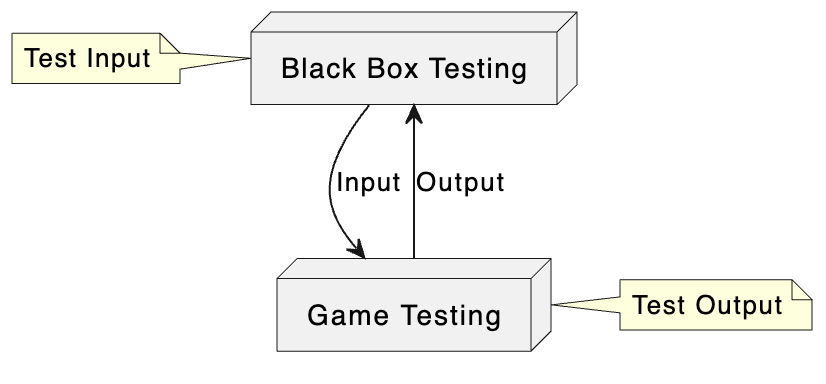
Clear Box Testing
It centers on the design and integration parts of the game software. For instance, the utilization of a database, pipelines, the integration and reconciliation of game segments like the AI engine, the rendering engine, sound, etc.
For Clear Box testing, the game tester must comprehend what coding is. The software tester employs a run-time troubleshooting environment, encourages the code or pieces of code with input, i.e., setting variables, data, and so forth, and interprets the test outcome.

Functional Testing
Its purpose is likely to be to recognize deviations from functional necessities. It comes down to driving through the game repeatedly to distinguish issues and the environments in which they can be rectified.
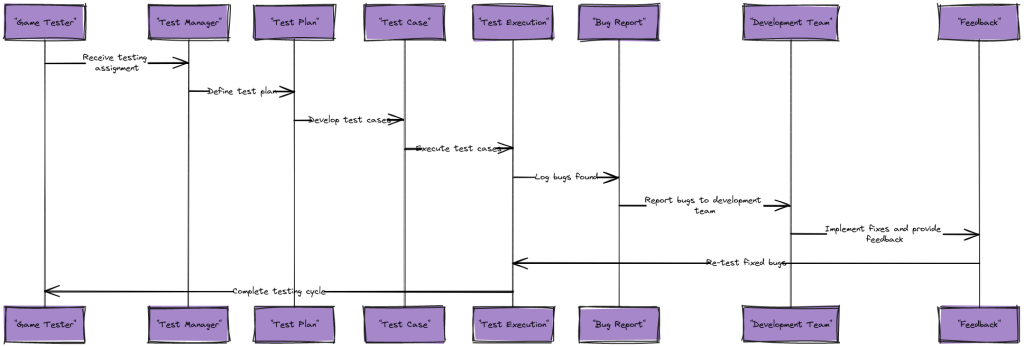
Stress/Load Testing
When testing the games, it is fitting to create conditions that require a huge computational load. So, the game tester can check system execution in an unpleasant condition. With load testing, it is less demanding to see and fix possibly perilous code segments in time. Test for odd circumstances, like loading a game with no memory card, running the game for 48 hours, and checking how the game reacts.

Combinatorial Testing
This type of testing is a process of experimental design that is applied for commercial software testing and to create test cases. Using combinatorial testing for game testing improves test performance efficiency, produces high-grade quality, decreases cost, and ensures reliable phase containment.
Every conceivable sequence of values of the parameters is incorporated into this test. Here the parameters are chosen from game elements, functions, events, character attributes, play options, settings, customization choices, and so forth.

Compatibility Testing
Much of the time, game programming is performed on laptops or PCs. Notwithstanding, numerous games can be intended for different devices: smartphones, game consoles, communicators, and so forth. Game development is performed on the test systems of these gadgets, yet they vary greatly from the original. In this way, later on, a few challenges may arise when beginning the game on the original gadget.
Plus, one should give careful consideration to the authorization of programming. In case of any aberrations, the game can be returned for correction, which takes additional time and a loss of funds. So, it is vital to check whether the game fulfills the necessities of the devices.
Feature Testing
This testing is performed to confirm the smooth functioning of the features in the game. For covering discrete features, detailed test cases are more appropriate. Task-based experiments require a predominant level of detail. At the point when there is an assortment of features for various player statuses, test frameworks get convenient and beneficial.
Critical Path Test
Critical path testing is a procedure to recognize the critical paths in the game. This type of testing technique uncovers the conditions that cause disappointment.
Play Testing
Playtesting is the technique of game testers playing the game to break down non-useful features like fun variables, balance, difficulty levels, and so forth. Here, a selected team of testers plays the incomplete variants of the game to check the work process.
Limitation testing:
The games are regularly converted into the languages of the nations where they are assumed to be made available on the market. It happens that translators can’t give a totally exact interpretation, which would be completely reliable with the game events. Indeed, even if interpreted appropriately, it may not indicate the circumstances and abrade on the ears of the local speakers. Thus, after localization, it is helpful to test the game by natives of those nations where the ultimate game would be available.
Smoke Testing
It is performed to test a new CD burn. The name Smoke Testing originates from the engineering lab testing new automobile engines. Before a new engine is taken for road testing, the engineers would just begin the engine and check whether it runs. In the event that smoke turns out from the motor, they would know promptly that a few sections don’t work appropriately.
Much like making another form, the game tester will essentially run the game; if it continues crashing, the tester will know a few sections are incorrect.
Regression Testing
This type of game testing is done to retest the unaltered parts of the product. Here, test cases are re-checked to investigate whether the operation of the past elements of the application works fine and that new changes have not presented any new mistakes or vulnerabilities.
Multiplayer Testing
Multiplayer testing is an entirely different beast in itself. Numerous players, all the while, associate with the game world, with game servers, with PC-controlled opponents, and with each other. Such huge numbers can turn out badly.
Furthermore, it regularly requires a complete team of game testers, various troublesome risk-based decisions to make, and the need to invest boundless amounts of time and energy in testing distinctive situations.
A comprehension of multiplayer game configuration and how to test proficiently as a group is required for this sort of game testing technique.
Sound Testing
Sound testing is common in all products that make some sort of sound or play media. But games have a one of a kind feature that other software does not need to consider on a similar level. Game music must include the user in the game and upgrade the gameplay. Not only should the sound play without missing or shuttering components, but it ought to likewise add to the gameplay. This demands broad sound aptitude and a particular comprehension of game audio. Quite a specific master of domain awareness.
Ad-hoc Testing
Ad-hoc testing is likewise, at times, alluded to as general testing. It is a less organized test. Ad hoc testing enables the game tester to investigate paths in view of their instinct. There are two types of ad hoc testing.
In the first place, there is free testing, which is a testing game with no arrangement or documentation. The other is direct testing, which is a solitary test performed spontaneously to answer a particular issue.
Test Flow Diagrams
Test flow diagrams are practiced to produce models depicting game behavior from the player’s point of view. Game testing involves examining the model along every potential path to examine unexpected game situations. A test Flow diagram is a formal way to test design. Since it is graphical in nature, it is simple to review, investigate, and give feedback on the test designs.
Complex test flow diagrams can interpret compact features, but typically, small test flow diagrams are preferable.
Test Trees
A test tree is a usability procedure for sorting out test cases that supports selecting an appropriate set of tests for a given arrangement of code changes. Test Tree enhances the general comprehension of complex game traits and deals with conceivably complicated functions, particularly when these functions connect with other game principles, elements, and functions.
The test tree is developed by disintegrating the element into a subset until the bottom nodes distinguish elements to utilize or spec to perform while game testing.
What is Bug Hunting?
Bug Hunting is a regular practice for some game testing companies worldwide, yet some test administrators wrongly feel they go Hunting when their game testers casually play with the application, keeping in mind the end goal of discovering “border case errors.”. Bug Hunts are Informal Testing activities; this should not be mixed up with playing with the system without a reason or goal.
- Bug Hunts should be directed as team activities.
- Bug Hunts are there so as to include non-testers and find less-ordinary bugs.
- Bug Hunts require the system to be steady to be helpful.
Thus, to accomplish something (and not waste your time and efforts!!) on performing these Bug Hunts, you have to follow a particular procedure, execute planning and preparation activities, as well as observe and control the procedure all through its execution.
Types of Game Bugs in Game Testing
Crash
A crash bug is a severe issue that freezes or completely shuts down the game, often leading to a “Crash to Desktop” (CTD) scenario. Executing particular commands, loading into new areas, or coming across specific enemies are just a few examples of the in-game actions that can cause these bugs. Crashes are considered high-priority bugs, and game developers prioritize eliminating them to ensure a smooth gaming experience..
General
General bugs are issues that do not halt game progression but still disrupt the gameplay experience. For example, a character disappearing unexpectedly, though not affecting the main storyline, can be classified as a general bug.
While these bugs may not be game-breaking, they can lead to player frustration and impact the game’s overall quality.
Minor
Minor bugs are small issues that have a minimal impact on gameplay but still need attention.
Examples include a character’s mouth not moving during dialogue or other subtle graphical glitches. Although minor bugs may not be prioritized, they contribute to the overall polish and professionalism of the game.
Severe
Severe bugs hinder the player’s progress without causing a game crash. These bugs can range from a disappearing character crucial for advancing a quest to a malfunctioning door preventing access to the next game area.
While not as critical as crash bugs, severe bugs are significant and must be addressed to maintain a coherent gaming experience.
Graphics
Graphics bugs primarily involve issues with the visual elements of the game, including texture errors and map imperfections. An example of a graphics bug is an incorrect ground texture applied to a door.
Addressing graphics bugs is essential for maintaining the aesthetic appeal and immersion of the game.
Sound
Sound bugs relate to issues with in-game audio, such as incorrect timing or missing music cues. These bugs can occur anywhere in the game, from the main menu to the closing credits.
Sound bugs can disrupt the game’s overall atmosphere and must be corrected for a complete gaming experience.
Algorithm Bugs
Algorithm bugs occur at collision detection points within the game. Incorrectly placed walls or floors can cause players to leave the intended map boundaries, indicating a failure in collision detection.
Fixing algorithm bugs is crucial to prevent players from getting stuck or experiencing unintended interactions within the game environment.
Fatal
Fatal bugs are game-breaking issues that prevent players from advancing further due to critical functionality failures.
An example is a jumping bug where a player needs to jump to progress, but the jumping mechanism fails, hindering progression. Fatal bugs demand immediate attention to ensure the game works correctly at all levels.
Configuration Trigger
Configuration trigger bugs occur when game settings have not been adequately tested, leading to failures.
These bugs can affect graphics and sound settings, potentially causing textures to disappear or altering audio configurations.
Configuration trigger bugs are uncommon in well-known games made by skilled programmers, but they can appear in online games that are downloadable.
How to Write a Bug Report Effectively?
A career as a computer games tester isn’t all fun and buffoonery. When you find a bug, you have to report it. Composing a game error report may look like a basic assignment. However, it is accompanied by a lot of duties. This is a correspondence from which other individuals will construct a plan of action with respect to game improvement. Those activities frequently incorporate submitting costly assets to settle the issue.
Here are a few tips for creating a bug report as a game tester. An adequate game bug report contains:
-
Title or Subject –
- Compile the critical elements of the issue.
- A basic overview of what, where, why, when, and how it is generated, featuring the most vital contemplations.
- Shows how extreme it is.
- Others utilize it to design a course of action; thus, it should be comprehended at once.
-
Classification
- A concise depiction of what, where, why, when, and how is generated with each and every detail.
- Here you ought to portray precisely “everything” about the issues.
- Classify it in such a manner that the reader can follow it entirely from the classification and comprehend totally what is going on.
- You may utilize industry-standard language to help precisely depict the issue.
-
Generation Steps –
- Well-ordered guide on the best way to replicate the issue.
- You ought to consider the individual heeding this guide has never observed the product and may even be new to the platform. Show them correctly what to do to reproduce the issue.
- Abstain from industry-standard language to guarantee the guide can be trailed by anybody.
-
Extra Information –
- Give additional helpful data.
- Assessment and theory, you can discuss how this bug may influence the player and conceivable inevitabilities created by the issue (such as bad customer reviews)
- Conclusions about different ways this may influence the game.
(Note: This segment is unnecessary in creating a report, though.)
What are the Opportunities as a Game Tester
Game-producing organizations, to achieve more profits, are always contracting computer game testers. So, finding the right source for the organization, whoever is hiring, is absolutely necessary. There are essentially three sorts of game testers. These are:
- Freelance Game Tester: The game testers who are freelancing are all around experienced and search out organizations that outsource forthcoming games to test the games. These testers are regularly the backbone of the game testing method. These game testers are usually contracted on a project-to-project basis. These testers are mostly used for black-box testing. Promptness, clarity, and communication in writing are critical attributes you should have.
- Full-Time Corporate Video Game Tester: There are potential people for being hired by big game-producing companies for full-time. For individuals who have a passion for playing games, no other activity can be as fascinating as this. Furthermore, the main capability required for this sort of employment is experience. No degrees or certificates are mandatory.
- Second-Party Testers: These game testers work on the testing team of a secondary or subsidiary organization under a bigger company. The second-party game testers can be either fully employed or contracted. Because of their close association with game developers, they frequently obtain access to more advanced tools. This usually results in a powerful focus on test cases and white-box testing. Most second-party testers are at least somewhat experienced in the game testing process.
Further, if you are looking forward to embracing video game testing as your profession, you must become more acquainted with the levels of game testing that are in charge of testing distinctive parts of the game. Quality assurance, Alpha testing, and Beta testing are the three primary kinds of game testing processes you will dependably need to begin with when you select this field as a profession. Alongside, there are other testing processes too.
Levels of Game Testing
-
Alpha Testing
- The initial testing phase is where the game is evaluated for major bugs.
- Involves internal testing by the development team.
-
Beta Testing
- A select group of outside users test the game during pre-release testing.
- Aims to identify potential issues and gather user feedback.
-
Quality Assurance (QA) Testing
- Comprehensive testing phase to ensure the game meets quality standards.
- Conducted by experienced game testers.
What is Gold Testing or Post-Release Testing?
This is the testing stage, where the game is completely tested, has been launched to the general population has a totally finished product, and players have total access to the game.
Despite the fact that the game is completely completed, there is plenty of chances where a player can discover glitches or even game-crashing bugs. Under these circumstances, the developers need to discharge patches with a specific goal to fix them.
In the Gold testing level, every single crucial bug (hangs, crashes, and function disappointments) is resolved. 90% of every single significant bug (performance and functionality) is solved.
85% of every minor bug (system execution problems that hit a few users) is settled. Furthermore, release-level performance (i.e., 60-fps frame rate) is accomplished.
During its life cycle, if the game was delivered with even a couple of terrible bugs, it’s the ideal opportunity for an update or patch.
For each patch, the dev team must return to the whole list of bugs and consolidate some new, clean features. Every individual bug patch or polish element implies more testing (yet should be prepared).
Each new fix must be tested to detect whether it works with the base game and prior patch versions.
Mobile Game Testing
While many testing techniques overlap between different platforms, mobile game testing presents its own set of challenges and considerations. Ensuring a mobile game functions seamlessly, adheres to specific requirements, and provides an exceptional user experience is no small feat, especially given the diverse array of mobile configurations.
The Significance of Mobile Game Performance
Mobile games captivate players with striking graphics, animations, and rich media. However, if the performance of a mobile game is lacking, these captivating elements become futile. Gamers expect a smooth, uninterrupted experience with consistent progress in gameplay. The importance of performance assessment cannot be overstated, as it directly impacts the player’s satisfaction and engagement.
Testing Navigation Flow, Usability, and User Experience
Emphasizing the genuine user experience, mobile game testing necessitates using actual devices rather than relying on emulators. Intricacies such as battery consumption, the impact of battery chargers, and potential intrusions significantly influence the overall user experience and entertainment value. Testing on real devices allows for a more accurate assessment of these factors.
Graphics Execution and Early-Stage Performance Tests
The graphics execution of a mobile game is intricately linked to user experience. While striking graphics and animations enhance the visual appeal, their effectiveness diminishes if the game’s performance lags. To address potential performance blockages, it is essential to conduct performance tests during the early stages of game development. Identifying and resolving performance issues early in the development process ensures a streamlined gaming experience.
Three Basic Phases of Mobile Game Testing
- Device Performance Testing
- Start-Up of Game: The initial screen should appear within 1-2 seconds of pressing the game icon. b. Memory Consumption: Adding functionalities increases memory usage, requiring careful management. c. Software/Hardware Variation: Test the game on various devices with different RAM and processor specifications. d. Battery Time: Continuous gameplay should not excessively drain the battery or cause the device to overheat. e. App in Background: Resuming the game from the background should retain its previous state. f. Usage with Other Apps: The game should run seamlessly when used simultaneously with other applications.
- Network Performance Testing
- Jitters: Networks using packet switches cause address delays in data transmission. b. Network Speed: Test the game on 2G, 3G, and 4G or 5G networks, including mobile networks and Wi-Fi.
- Testing API/Server Performance
- API Calls: Limit the number of calls from the game to ensure optimal performance. b. Information To and From Server: Efficiently handle data transmission between the game and server. c. Server Down Time: Implement failover database servers to ensure continuous availability in case of server issues.
Conclusion
Effective game testing is a structured and comprehensive process that involves various types of testing techniques. From functional testing to stress testing and bug hunting, each step is crucial in ensuring a flawless gaming experience for users. Understanding the components of games that undergo testing, the types of testing involved, and the techniques used are essential for game testers and developers to deliver high-quality games to the market. The iterative nature of the testing process ensures continuous improvement and refinement, ultimately contributing to the success of the gaming industry.




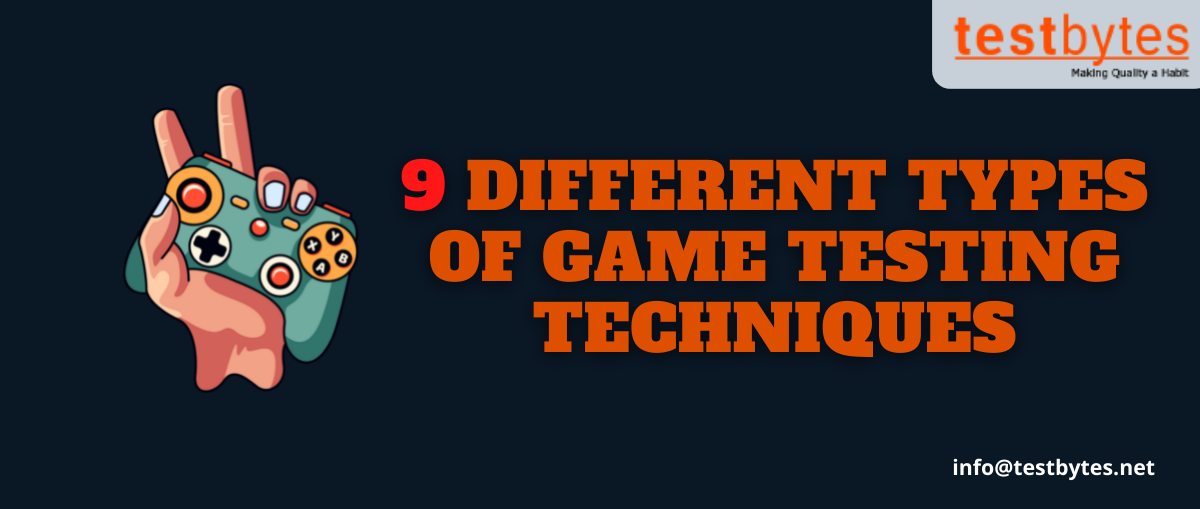


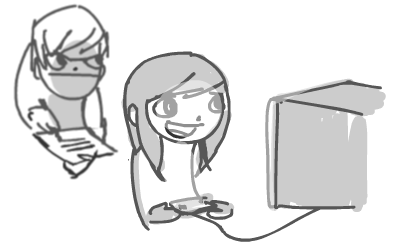




![Top 23 Gaming Glitches of All Times [Full-List with Video]](https://wp.testbytes.net/wp-content/uploads/2019/06/Top-23-game-glitches-of-all-times-compressor-1.jpg)



